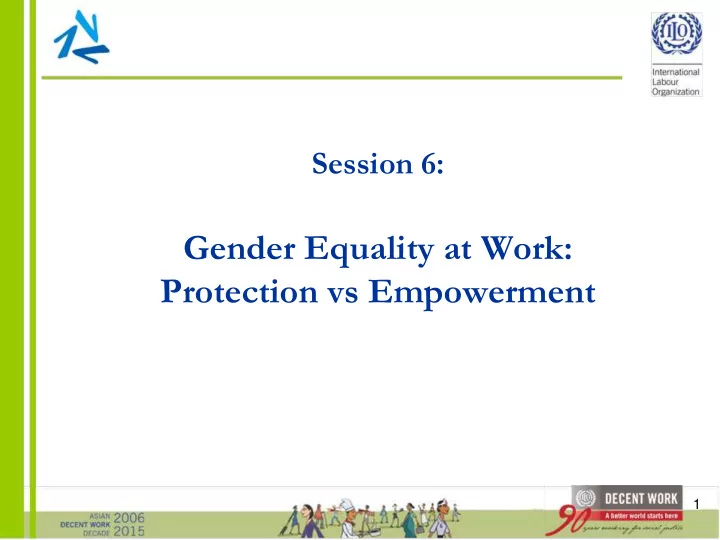

Session 6: Gender Equality at Work: Protection vs Empowerment 1
Learning objectives 1. Identify policy and practical measures to promote and enforce substantive equality among men and women at work. 2. Detect common forms of sex discrimination in the employment cycle. 2
Changing approaches (1) From protection to gender equality in law and in outcomes 1. Protective equality --- early 20 th century • Women were perceived as more fragile than men and in need of special protection. • The earliest ILO Conventions prohibited the employment of women at night, underground and with dangerous substances. • Later the protectionist perspective was repealed, as it hindered women’s equal access to employment. 2. Equality in law --- mid 20 th century • Gender equality was recognized as a human right in the Universal Declaration of Human Rights (1948). • Emphasis in ILO standards shifted to removal of barriers to women’s employment, e.g. repealing discriminatory provisions in national laws. • In some countries equality in law was understood as formal equality , i.e. treating men and women the same way regardless of their biological and social differences. • Due to the lack of gender perspective , equality in law does not provide effective protection to the rights of women . 3
Changing approaches (2) 3. Equality in outcomes (substantive equality ) --- 1980s onwards • Removal of legal barriers to women’s equality in the labour market had not been enough to realize equality of employment outcomes. • The emphasis shifted on putting in place affirmative measures to redress the effects of (past) discrimination and promoting equal opportunity and treatment in the labour market. • Gender mainstreaming and women’s empowerment have become the main global strategies to promote gender equality. 4
Policy measures (1) Protective and affirmative measures to promote gender equality at work: • Most countries have adopted national policies or action plans for achieving gender equality and advancing the position of women. • Two types of special measures are generally needed for gender equality: Protective measures and affirmative measures 1. Protective measures a. Measures to protect women’s reproductive and maternal capacity – maternity protection, special conditions of work for pregnant women and nursing mothers – The need for these measures is almost universally accepted, but effective policies are still lacking in most countries b. Measures to protect women due to their perceived vulnerability and ”need for protection” – Need for these measures is under heated debate ! – E.g. prohibition of night work or work underground 5 5
Policy measures (2) 2. Affirmative action measures (positive measures) • Special temporary measures designed to redress the effects of past or continuing discrimination • E.g. targets, goals and quotas for the participation of the disadvantaged under- represented group. • Principle of affirmative action measures is reflected in Article 5(2) of Convention No.111, and has been reconfirmed regularly over the past decades in international conventions, resolutions and declarations. 6 6
Recommend
More recommend